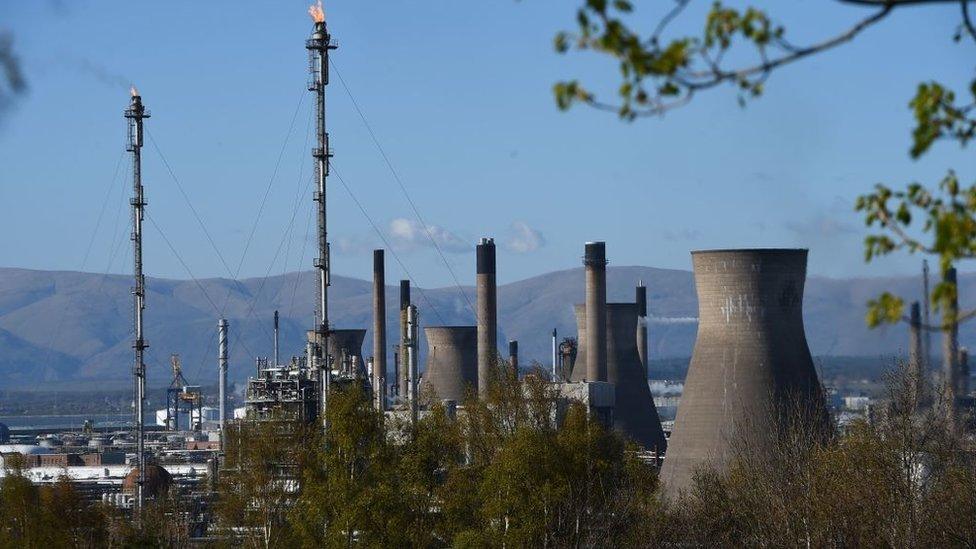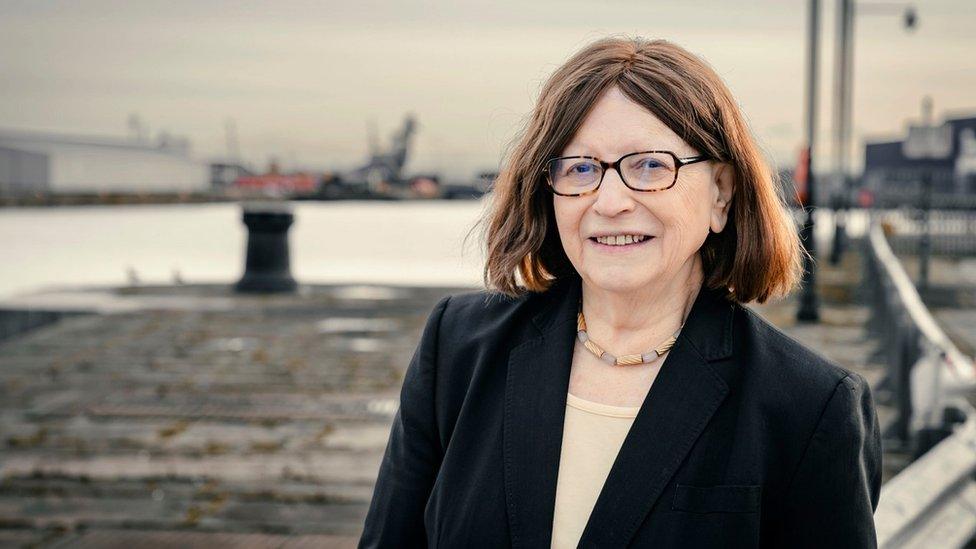Freeports go Forth and multiply
- Published

The owners of Grangemouth refinery have shocked the energy industry with their signal that the transition away from fossil fuels has started and means a lot of jobs losses
The "just transition" lacks detail, but can pin some hopes on Scotland's two "green freeports".
The Firth of Forth partnership plan aims for 38,000 jobs in and out of the zones. It now includes the Royal Navy and includes Ineos, the oil and chemicals giant at Grangemouth, which wants to expand biofuels and hydrogen production.
The idea of a "just transition" from fossil fuels to renewable ones is coming under uncomfortable scrutiny.
As PetroIneos pulls out of refining oil at Grangemouth, it doesn't seem that "just" for around 400 people losing their jobs.
They can reasonably ask if the transition, for them, is just rhetoric or just around the corner. And around 90,000 others with livelihoods dependent on the oil and gas industry will be looking on nervously.
If Scotland's only refinery closes and becomes a terminal for imported fuels, a vital element in the pipework of the industry is being removed. Nobody in the sector can feel as safe after that.
Whether it's just or even a transition, there is reason to hope. Renewable energy is growing and is set to grow much faster, as the vast ScotWind offshore projects take shape and ramp up activity.

Two focuses for that optimism are the green freeports - one chosen on the Cromarty Firth and Inverness, the other on several locations around the Firth of Forth.
The idea is to have designated land for industrial development, with low taxes on property and employment, and no customs tariffs for in- or outbound trade. The Scottish variety is meant to be focused on renewable energy and low carbon enterprise.
There is also pressure to ensure they don't become a magnet for employers with a low-wage business model, which is how freeports tend to turn out in other parts of the world.
Highland housing
They've been a long time coming. A long bidding process reached that winning selection in January. While England has freeports up and running (and is already facing claims of fraud in at least one), more than 10 months later in Scotland, we now have at least an outline of the Outline Business Case for both zones in Scotland.
The Highland one laid out the plan for councillors to see, so we were all able to take a peek: 10,000 jobs, £3.5bn investment over 25 years, while diverting National Insurance payments into a large training fund.
At Inverness Chamber of Commerce, they're optimistic, but the recurring concerns are about where those 10,000 people are to come from, how can they be adequately skilled up, and if they can be recruited, where is the housing for them, and the transport infrastructure for them to use?
There are more urban versions of those for the Forth green freeport, which this week issued an outline of its Outline Business Case.
We don't get to see the whole document until the outline business case becomes the final variety. Although the Highland and Forth bids have won, they still have to negotiate the terms with the Treasury and the Scottish government. That will take further months to conclude.
That's Fife
The big Firth of Forth numbers are around 19,000 direct jobs inside the green freeport zones, and a further 19,350 jobs resulting from activity in these zones, but not directly employed inside them.
The plan has expanded to include part of the Rosyth dockyard owned and controlled by the Royal Navy, which has duly become a partner.
Burntisland docks in Fife are also seen as expanding the role initially envisaged for them of being a customs-free zone. These could now become a low-tax zone for manufacturing for the offshore wind industry.
The bigger players are at Leith Docks and Grangemouth, with a customs-free zone at Edinburgh Airport.
Grey ships and blue chip
That takes us back to the plight of the vast refinery and petro-chemicals complex in Falkirk Council area.
Ineos is a partner in the Forth Green Freeport project. With Sir Jim Ratcliffe having homes in Monaco and Switzerland as well as England, and with his holding company based in Luxembourg, Ineos is adept at working tax regimes to its advantage.
The boundary line of the Forth Green Freeport zone is designed to cut out the Grangemouth refinery and much of the oil and gas processing works, instead including parts of the site designated for low-tax development of hydrogen production and biofuels.

Dame Susan Rice has been appointed to oversee the project
There is a race on to get to five biofuel plants in the UK by 2025 making SAF, or sustainable aviation fuel. On Tuesday, from Heathrow to New York, Virgin Atlantic pioneer the first transatlantic airliner flight powered entirely by SAF, which is made from agricultural waste and used cooking oil. A tiny part of aviation fuel so far, it is seen as the best way of taking carbon out of flying.
On the north bank of the Forth, Rosyth and its main operator, Babcock, have hopes of greener modular shipbuilding, so there may also be more than a touch of battleship grey to the freeport colour scheme.
At Leith Docks, Forth Ports is clearing space and strengthening the quayside to accommodate the very large barges required for carrying offshore wind turbines.
The intention overall is to get £7bn of investment from public and private sources, to create £8.5bn of value added to the Scottish economy. You could say that it is going Forth and applying an economic multiplier… but maybe it's best not to.
Atop this, a new chairwoman has just been appointed to oversee the project. Dame Susan Rice brings blue chip credentials, having been the first woman chief executive of a British bank as well as chairwoman of Lloyds TSB Bank, she was initial chair of the Scottish Fiscal Commission, a board member of SSE, Sainsbury's and the Bank of England, and she is currently chair of Scottish Water. A quietly-spoken American by birth, she's not finished yet.
Related topics
- Published3 October 2023